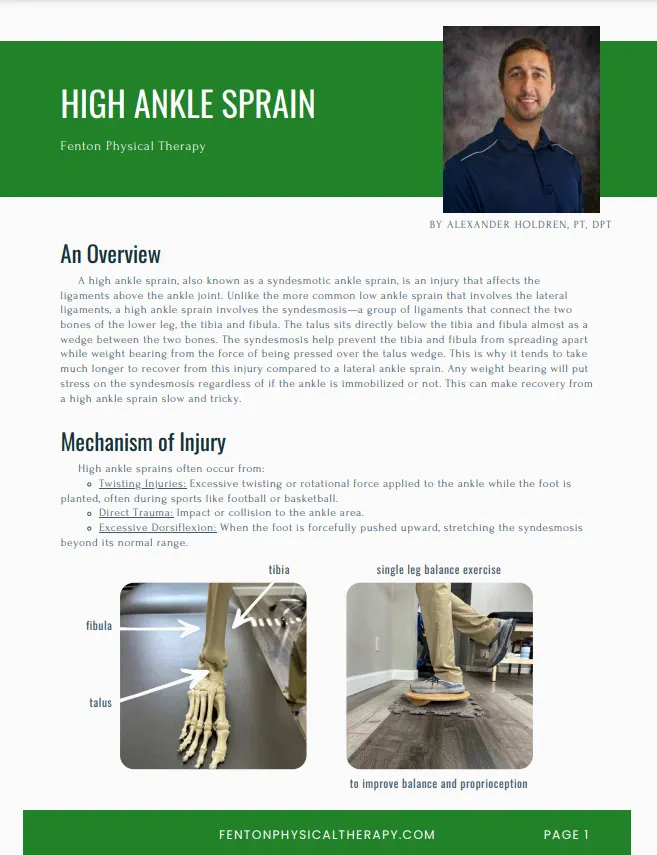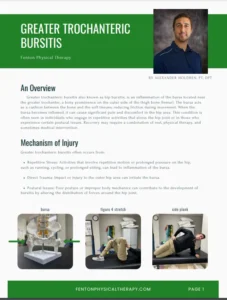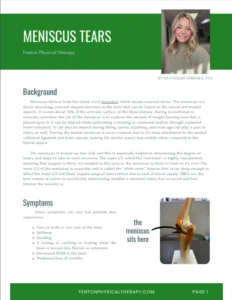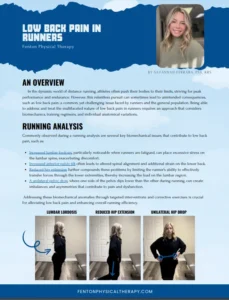An Overview
A high ankle sprain, also known as a syndesmotic ankle sprain, is an injury that affects the ligaments above the ankle joint. Unlike the more common low ankle sprain that involves the lateral ligaments, a high ankle sprain involves the syndesmosis—a group of ligaments that connect the two bones of the lower leg, the tibia and fibula. The talus sits directly below the tibia and fibula almost as a wedge between the two bones. The syndesmosis help prevent the tibia and fibula from spreading apart while weight bearing from the force of being pressed over the talus wedge. This is why it tends to take much longer to recover from this injury compared to a lateral ankle sprain. Any weight bearing will put stress on the syndesmosis regardless of if the ankle is immobilized or not. This can make recovery from a high ankle sprain slow and tricky
Mechanism of Injury
High ankle sprains often occur from:
- Twisting Injuries: Excessive twisting or rotational force applied to the ankle while the foot is planted, often during sports like football or basketball.
- Direct Trauma: Impact or collision to the ankle area.
- Excessive Dorsiflexion: When the foot is forcefully pushed upward, stretching the syndesmosis beyond its normal range.
DOWNLOAD THE PDF TO VIEW THE ILLUSTRATIONS
Recovery Timeline
- 1. (1-2 Weeks): Initial pain, swelling, and bruising. Rest, ice, compression, and elevation (RICE) are crucial during this period. You may need to use crutches or a brace.
- 2. (2-6 Weeks): Gradual increase in range of motion and weight-bearing activities. Physical therapy will focus on gentle stretching and strengthening exercises.
- 3. (6-12 Weeks): Full return to normal activities with an emphasis on functional and sport-specific training. Strength and stability exercises are key during this phase.
- 4. (12 Weeks +): Most individuals regain full function, though recovery times can vary based on the severity of the sprain and adherence to rehabilitation.
What to Expect in a Physical Therapy Session
- History and Evaluation:
- Discussion of your injury, pain level, and functional limitations.
- Physical Examination:
- Assessing range of motion, swelling, and strength.
- Modalities:
- Ice, heat, or electrical stimulation to reduce pain and inflammation.
- Gentle Stretching:
- To restore normal movement in the ankle and surrounding areas.
- Isometric and Resistance Exercises:
- Focused on rebuilding strength in the ankle, lower leg, and core.
- Balance and Proprioception:
- Exercises to improve stability and coordination.
- Sport-Specific Drills:
- As recovery progresses, tailored exercises to help you return to your regular activities.
- Injury Prevention:
- Strategies to avoid re-injury and proper techniques for activities.
Summary
High ankle sprains can be very painful and tend to take longer to recover from than lateral ankle sprains to recover from. High impact activities and pushing off the foot to run will take the longest to get back to due to the motion required at the ankle in order to produce these forces. In some cases, if the damage to the syndesmosis is large enough, surgery may be required in order to repair the ligaments. Generally, physical therapy is safe and effective and you can begin around 1 week after a syndesmotic injury.




